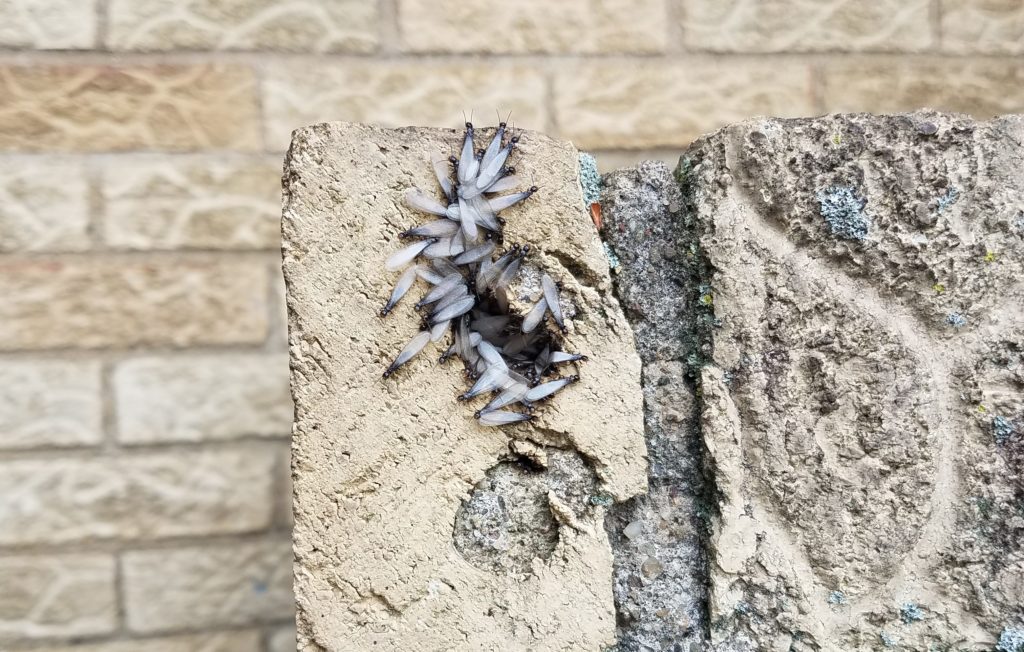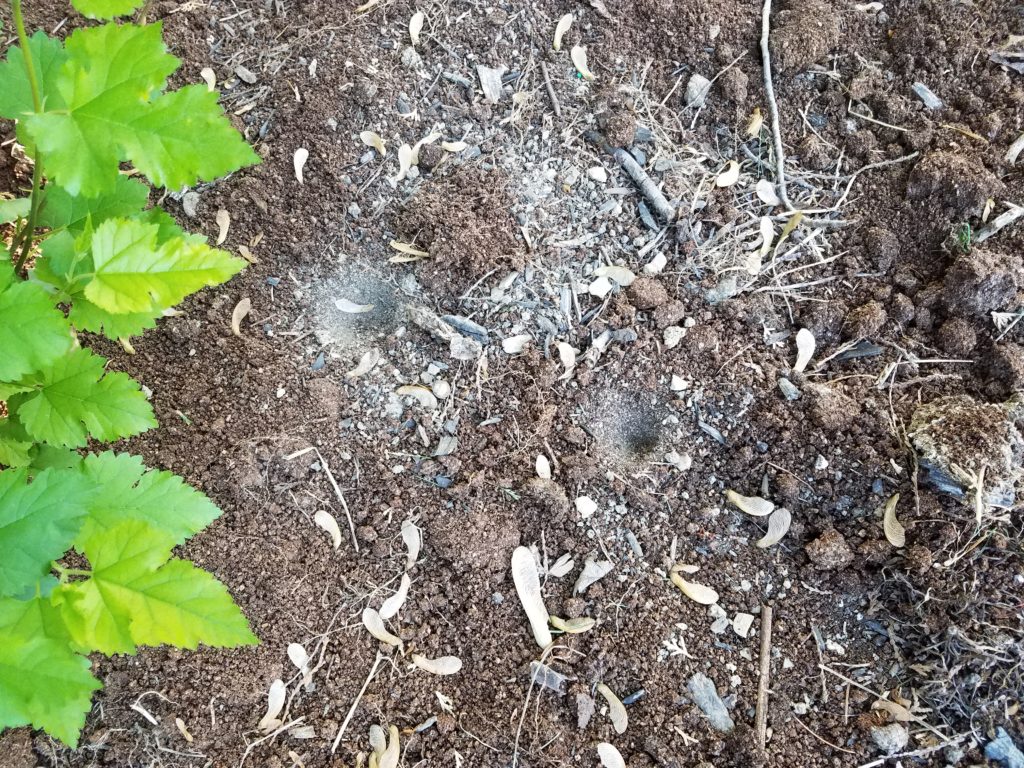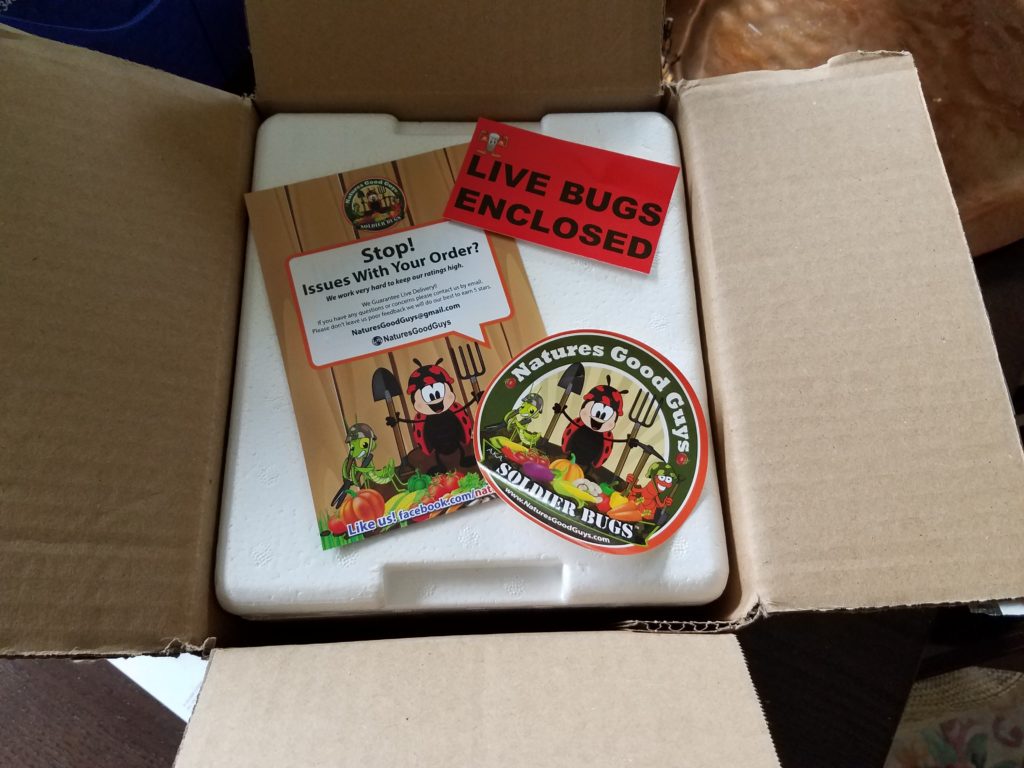It had to happen sooner or later. Having a house is a full-time job and requires constant vigilance for threats. A few weeks ago I was enjoying a gorgeous afternoon on the porch when I noticed some bugs crawling out of a hole in one of the bricks lining a garden planter. These “some bugs” turned out to be termites coming out for their nuptial flight, as my subsequent internet research would tell me. Christian happened to be away that weekend, so I took the time to acquaint myself with just what they are, how they live, and what methods can be used to remove them. My goal was to have a reasonable discussion of our alternatives when my husband returned home and come to a decision jointly about the best way to proceed.

First, I want to remind you the readers that I like to keep this blog a judgement-free zone. I understand the reflex to call an exterminator and eradicate these insects that could destroy the largest investment you will ever make. My desire in this situation was to understand all of my alternatives before picking up the phone and choosing the nuclear option. I have worked hard to cultivate and nurture a delicate ecosystem in my yard, and I wanted to avoid – if at all possible – spraying poisonous chemicals that could harm bees, flies, birds, our cats, us, etc. I understand that what I want isn’t always what I need, but this post will describe the measures we have taken to date, with the knowledge that we may need to go to greater extremes in the future.
Termites
I was honestly surprised to see any at all because not only have I never seen any evidence of them inside, but I was always told that house centipedes are a great line of defense against termites, silver fish, cockroaches, bed bugs, and other things that might be harmful to you or your house. We do have house centipedes (and I have come to an uneasy truce with them), so I assumed that meant we were safe on the termite front. So, just to reiterate, although you may believe that house centipedes look like Satan’s eyebrow (which is literally what we called them in college when they appeared in our dorm), one of your best lines of home defense is to leave them be and let them eat the pests that really do pose a threat.

I feel a little silly posting a link to a Wikipedia page as a source here, but the section on termite reproduction was utterly fascinating and terrifying. I would highly recommend reading it if you’re sure you don’t have them in your house. (If you do have them, maybe wait until they’re under control before clicking that link.) The termite queen can live up to 50 years, eventually laying 40,000 eggs a day once she is fully mature. The king and queen mate for life, but the queen can reproduce on her own, asexually, if her king dies, and the king can create a replacement queen from the worker population through his pheromones if his queen dies.
They eat cellulose, major sources being lumber and dead plant material, and are so plentiful that their digestion of these materials is considered to contribute to 11% of atmospheric methane. (Can we just get rid of termites to help reduce global warming?) Although there are over 3000 species all over the planet, there are only 83 that pose a significant threat to wooden structures.[1] From what I understand, the ones that we need to worry about live in hives in the ground, outside the house. The workers burrow into the house to find food, which is why many solutions involve putting some kind of barrier (physical or chemical) around the foundation, blocking the path between the nest and the house.
Integrated Pest Management
I have learned about this term, IPM, in multiple venues – first while helping my neighbor with his beehives, then as part of my day job in healthy homes, and now again in my own research related to the termites. The concept is that no one thing will be perfectly effective, but that many measures together, focusing on prevention, will make a difference.

Prevention is always the first place to start, with harsh chemicals considered to be the last resort. Whether you’re dealing with mice or termites, you want to be sure that they do not have a way into your house. Sometimes that takes care of the problem entirely. Working backwards and starting with harsh chemicals can put the health of your family and pets at risk, and while you have killed some pests, their door into your home is still open, meaning that more may come in, and you will need to take additional action of the same kind in the future.
1) Prevention –
Before you do anything else, regular (ideally monthly) inspections of your home to look for damage are essential. Make sure that pests are not present, and take steps to ensure they can’t get in.
The ideal first step for prevention is to create a barrier that the termites will not be able to penetrate. Ideally this barrier would go up during construction of the house, covering exposed wood with a sealant or metal. If your house was constructed without one, it is possible to dig down and put in a barrier, which can also include sand and/or steel mesh. Interestingly, I did find a large amount of sand buried next to the foundation when digging a new garden bed this year, so we may have a barrier in place already.
You will also want to take steps to make the house unattractive to termites, which includes making sure that drainpipes are properly diverting water away from the house, filling cracks or penetrations in the foundation and walls, fixing leaks as soon as they are found, making sure that plants and trees are not too close to the structure and do not touch any exposed wood surfaces, and moving firewood or debris piles away from the house.[2]
2) Organic Pest Control –
Many people have an inclination to get rid of all bugs, but some, such as picnic ants (not carpenters), spiders, and house centipedes, are actually already doing battle with the pests you need to be worried about. Supporting a strong defensive army of beneficial bugs can often be more effective than killing everything you see.
Non-chemical alternatives are the next step, and some websites for organic gardening are helpful in listing options you might consider before going the chemical route.[3] One commonly-recommended solution appears to be the application of beneficial nematodes. Nematodes are microorganisms that attack specific types of insects, such as termites, where they live. I had first heard about them at a beekeeping conference in a seminar on IPM, as they can be used to attack small hive beetles without harming the bees. The nematodes are carried down to the nest via water (best results are achieved by keeping the soil moist for two weeks after application) and enter the termite larvae’s digestive tract. The nematodes will basically eat the termite from the inside out, multiply, and move on. Reading the description of how they operate almost makes me feel bad for the termites (almost), but then I remind myself that we have to protect our house.

3) Chemical Solutions –
While many people go here first, it should be the last step after other options have been tried, exhausted, or duly ruled out. This is probably the easiest option, but it comes with the highest health risks and shouldn’t be taken lightly.
Finally, as a last resort, there are some products that will do the job to kill the termites, but they will also risk harm to other living creatures as well. Again, I would like to point out that I do my best to keep judgement off this blog. It appears we have the luxury to try less invasive / more preventative options because we haven’t found any damage inside the house. I understand that not everyone is in this situation and severe infestations require more than a sprinkling of nematodes. I truly hope that we will not need more than the preventative and organic solutions steps for our home. However, not everyone is that lucky, so if your situation is very bad and you do need to continue to this third step, the EPA has some great resources on how to go about doing that in a responsible way so you don’t use more than you need and you do avoid harm to your family, your pets, the birds and other animals in your yard, and the groundwater.[4]
Bug Fighting to Date
When Christian got home, I had my research and recommendations ready, stopping just short of having a PowerPoint prepared. After I was done presenting my case, he let me know that he was aware that termites lived in the yard, that he had never seen any evidence of them inside either, and that if I wanted to start by trying out the nematodes, he was on board with that.
I’m glad we talked about it.
We ordered the nematodes, and I poured them in the garden in three spots: where I saw the termites emerging that first afternoon, where I saw what looked to be exit holes of some kind in the ground nearby, and where our wood pile used to be, against the house. I say “used to be” because by then I had moved it to sit next to the shed. Interestingly enough, I found very old termite bait traps (put there by the previous owner) in two of those locations. I did feel terribly guilty knowing that I would also be killing off the ants that were likely helping to keep the termites at bay. My concern is that we will be more susceptible to termites in the future with the ants gone too, meaning we may have to redistribute the nematodes on a yearly basis, as the package recommends. Still, I am happier with this alternative than I would have been with baits and poisons.
I hope that with vigilance, prevention, and maybe some additional nematode applications in the future, we will not have to turn to chemicals. More updates to come as we have them.
Thanks for reading!
[1] https://en.wikipedia.org/wiki/Termite
[2] https://www.epa.gov/safepestcontrol/termites-how-identify-and-control-them
[3] https://www.planetnatural.com/pest-problem-solver/household-pests/termite-control/
[4] https://www.epa.gov/sites/production/files/2017-08/documents/citizens_guide_to_pest_control_and_pesticide_safety.pdf
3 Comments
Julia Zebley · May 19, 2019 at 12:18 pm
“I took the time to acquaint myself with just what they are, how they live, and what methods can be used to remove them. My goal was to have a reasonable discussion of our alternatives when my husband returned home and come to a decision jointly about the best way to proceed.” I read this at first like you were going to try to negotiate with the termites, and I was like, “well that’s certainly a green solution.”
Alison · May 19, 2019 at 5:02 pm
Haha! They call me the termite whisperer.
Spotted Lanternfly 101 – Radical Moderate · January 14, 2021 at 10:18 pm
[…] [1] https://radicalmoderate.online/integrated-pest-management-termites/ […]